AG TIRE TALK KEY TAKEAWAYS
YOKOHAMA: “Like so many segments in the tire industry, sprayer tires have become very specialized—it’s really the opposite of a one-size-fits-all market…we’ve seen amazing response to the unique hybrid tread pattern—industrial-style tread blocks arrayed in an R-1-style curved pattern to enhance traction and self-cleaning…”
MICHELIN: “Compared to a tractor tire, the stability of a sprayer tire is of utmost importance. Sprayer tires are specifically designed to handle the constant pitch and sway of a machine loaded with liquid, in addition to the dynamic loads, with a very high center of gravity.”
TRELLEBORG: “A major difference between a tractor tire and a sprayer tire is tread depth…the term tractor is derived from the Latin word “trahere”, which means “to pull.” Consequently, a tractor tire needs to pull whereas a sprayer tire needs to float on the ground and provide some traction, but flotation and stability are its main contributors.”
BKT: “Standard tires for tractors and tires for sprayers can be the same sizes, which can lead to some confusion…farmers should be careful to make sure that the tires used can carry the weight of the load and are rated for the speed.”
CONTINENTAL: “A high void ratio means there is more gap in the tread than rubber contacting the driving surface…This is a benefit for self-cleaning efforts and soil compaction, common to tractor tires. A lower void ratio provides good traction, a smoother/more comfortable ride and provides better stability, common to sprayer tires.
PRECISION INFLATION: “Which is better, Standard, IF or VF? If soil compaction, flotation and soil health is important, then IF or VF are the best choice for sprayer and tractor high load requirements.”
MAXAM: “In sum, as a general rule the following sets a sprayer tire apart from a tractor tire: lower void ratio, higher weight carrying capacity, shallower tread, and higher speed rating.”
Trelleborg Wheel Systems
Norberto Herbener: OE Applications Engineer
Let’s start this AG Tire Talk with some basic definitions:
A tractor is a vehicle designed to provide a high tractive effort (pulling force) at slow speeds in order to haul a trailer or machinery used in agriculture or construction. The term tractor is derived from the Latin “trahere”, which means “to pull.”
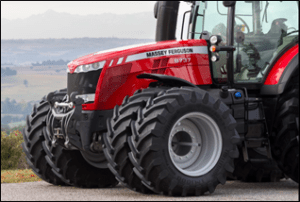


Agriculture sprayers are complete spray systems engineered for generating pressure to drive spray fluid from a tank out to the sprayer’s nozzle(s) to crop or soil. Sprayers are most often used for the administration of water, insecticides, pesticides, herbicides, and fertilizer. Sprayer tires need to pass over the soil and crops consequently high traction is not necessarily needed. High speed is also a necessity.
Obviously these two definitions are very different, consequently they will need very different tires. However, in today’s farming climate, there are times where a sprayer tire size can be used on a tractor and a tractor tire size can be used on a sprayer.
Let’s talk about various differences between Tractor tires and Sprayer tires:
WORKING SPEED
The need for higher productivity in the world’s agricultural industry drives the professional and extensive use of modern sprayers. New generations of fertilizers and self-propelled high-powered sprayers require a significant upgrade in tire technology to cope with new, high demand applications, through high load, stability, and reduced fuel consumption. Current sprayers and spreaders normal working speed is between 25 and 30 mph. Transport speeds are up to 45 mph. Sprayer specific tires must at least have a speed symbol of “D” (40 mph).
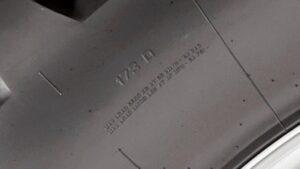
Sidewall markings as shown below indicate the tire has a Load Index of 173 and a Speed Rating of “D”. This enables the speed to comfortably carry its rated load at 40 mph.
On the other hand, a tractors normal working speed is between 5 and 15 mph. For that reason, an A8 speed symbol is normally sufficient. With the future trend on increased transport speeds between fields, new generation tires (VF technology) tend to include “D” (40 mph) and up to “E” (50 mph) speed ratings.
TREAD DEPTH
Another major difference between a tractor tire and a sprayer tire is tread depth. As we read in our opening comments, the term tractor is derived from the Latin word “trahere”, which means “to pull.” Consequently, a tractor tire needs to pull whereas a sprayer tire needs to float on the ground and provide some traction, but flotation and stability are its main contributors.
Sprayer tires normally have an R-1 tread design, where as a tractor tire normally has an R1-W tread design. The main difference is an R1-W lug design is 20% taller than an R-1 and assures a higher traction transfer from the tractor to the ground. Below details the difference:
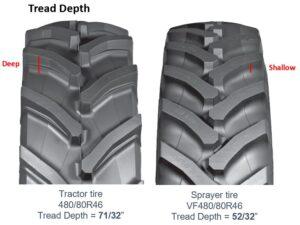
The advantages:
- Tractor tire is designed with the deeper tread. It will provide more traction and pulling power.
- Sprayer tire is designed with the shallower tread. It will provide more stability, less heat build-up and a smoother ride on the road.
TREAD DESIGN
The tread design on the right is that of a sprayer tire and the picture on the left is a tread shot of a high horsepower tractor tire.
Note the difference between the two patterns. First to note is the pair of lugs in each design, on the sprayer tire we have 29 pairs of lugs vs 23 pairs on the tractor tire. The tread void or lug void is a lot smaller or narrower on the right sprayer tire vs the left tractor tire. Tread void or lug void is defined as the distance between the lugs and in the case of the sprayer tires its smaller as we have more lugs. The lugs being closer enables the tread to provide a much smoother ride. A sprayer tends to spend more time roading than a tractor. The lugs are wide to guarantee stiffness when the machine is operating under high load when the tank or hopper is full.
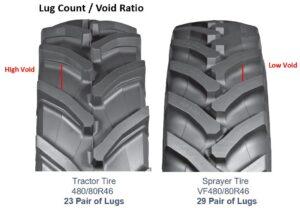
FLOTATION TIRES vs SKINNY TIRES
Over the years, the Application business has become quite sophisticated. These Service Providers or even the End User now will often use two kinds of Sprayer tires.
The base sprayer tire size is 380 millimeters wide. Common sizes would be 380/90R46, 380/105R50 and are used mostly when the crop is already planted and growing, able to run post-emerge between the rows.
During the Spring and sometimes in the Fall when the soil is moist, soft, and normally no row crop is in place pre-emerge, a wider tire is preferred to float more on top of the soil. Consequently, a larger cross-section or tire width is preferred. A popular flotation tire size would be 650 millimeters wide. Examples would be 650/65R38 and even wider 750 millimeters example 750/60R46. Mitas has recently released two new VF flotation tire sizes both in NRO (Narrow Rim Option) exclusively for the sprayer tire market:
- VF 650/65R38 NRO
- VF 750/60R46 NRO
As you can see, the tire on the left is a wider tire. The cross-section or section width would be 650 millimeters (25.5 inches).
The tire on the right is the traditional sprayer tire used once the crop is growing and the machine needs to go down the rows and not damage the emerging crop.
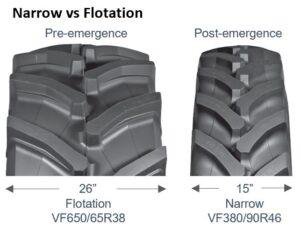
VF Technology for Maximum Load Capacity AND LARGE FOOTPRINT
Sprayer tires feature VF technology. VF technology enables the tire to carry up to 40% more load at the same air pressure. It also allows the tire to be used at up to 40% less air while carrying the same load. This while maintaining the 40-mph speed capability.
The graphic below shows the relative higher capability of VF tires compared to Standard tires.
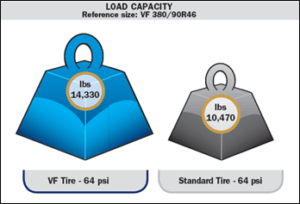
In sum, choosing the correct tire for the application will provide the customer the performance and payback that is required in this challenging agricultural business.
Blaine Cox
National Product Manager–Agriculture, Golf & Turf
Yokohama Off-Highway Tires America, Inc.
Like so many segments in the tire industry, sprayer tires have become very specialized—it’s really the opposite of a one-size-fits-all market. There are some common denominators.
For instance, applicators need to protect crops, whether it’s by running between the rows of standing crops or by minimizing soil compaction, especially if they are running on wet, compaction-prone soils. They need precise, reliable steering, without the squirrely wobble that many older-style tires can create. Good roadability is an absolute must to cover as many acres as possible in a day—that’s critical to maximize income or ROI, and also to react with protection when the crops need it. And applicators and managers have come to recognize the value of a smooth ride to help maximize productivity.
Finally, they need to handle heavy loads, which has driven a lot of enthusiasm for our VF sprayer tires. VF technology permits up to 40% more weight at the same inflation pressure as conventional radials of the same size, or allows applicators to reduce inflation pressure by up to 40% to carry the same load as a conventional radial.
Yokohama Off-Highway Tires America, Inc. offers a wide range of tread patterns and constructions for sprayers of all kinds to help farmers and custom applicators match their tires to their business model, soils, crops, and even the time of the season.
We have our optimized version of a classic R1-W lug in our Alliance Agriflex+ 354 VF radial, which offers outstanding traction and self-cleaning that keep sprayers running even in wet soils.
But we’ve also seen amazing response to the unique hybrid tread pattern—industrial-style tread blocks arrayed in an R-1-style curved pattern to enhance traction and self-cleaning—in our Alliance Agriflex+ 363 VF radial. Applicators comment on the steady, stable ride of the 363 in the field and over the road, which is a benefit the low rubber-to-void ratio. Meanwhile, the large number of biting edges from all those tread blocks provides outstanding stability on slopes. The Agriflex+ 363 VF has been a game-changer in the sprayer market.
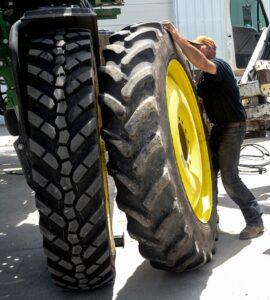
Alliance Hybrid AgriFlex+ 363 Figure LEFT
While our row crop tires get a lot of attention on self-propelled sprayers because so much crop protection is accomplished post-emergence, we also help applicators excel with their high-flotation sprayers as well as other heavy spray equipment like air-blast sprayers in orchards. In those segments of the market, our expertise in flotation tire construction—including high-speed flotation tires capable of operating at highway speeds on pavement—is a decisive advantage.
Choosing the best sprayer tire takes a little consideration, but it’s time well-spent. The right tire can help maximize the productivity and impact of an application rig at times when the stakes are high and the crop—or an applicator’s bottom line—are at stake.
BKT USA, Inc.
Dave Paulk: Manager Field Technical Services
Although tractor tires and sprayer tires are used interchangeably at times, there are major differences concerning the two applications. Standard tires for tractors and tires for sprayers can be the same sizes, which can lead to some confusion.
An example is a 380/90R46, a popular size used on both tractors and sprayers. The 380/90R46 is made in a standard tire for tractors, and IF and VF versions for sprayers. A standard BKT tractor tire, the RT945 380/90R46 159A8/B is rated to carry 9,640 lbs at 58 psi at 30 mph. A BKT sprayer tire VF 380/90R46 AGRIMAX SPARGO is rated to carry 13,760 lbs. at 61 psi at 40 mph. There is quite a bit of difference between the standard and VF in speed and load carrying capacity.
Most modern self-propelled sprayers are heavy and run 40 mph carrying a lot of liquid weight. They are driven on the highway to get to the fields. The tires used for this application must be able to handle the speeds, loads, and the highway with some stability. These tires are generally R-1’s. An R-1 has more lugs (less void ratio) for highway contact and a shallower tread depth for less squirm from the lugs. Traction is generally not as much of a concern for sprayers as it is for tractors. For this application, tires should be IF (20% more load than a standard tire) or VF (40% more load than a standard tire) rated to carry the excess weight. Since air carries the weight, the IF’s and VFs are rated for a higher air capacity than standard tires. The VFs are better in this application because of the higher load carrying capacity and 40 mph rated speed.
There are smaller self-propelled sprayers on the market that require smaller tires. These smaller sprayers don’t have the heavy weight and run the high speed of the larger sprayers. Again, farmers should be careful to make sure that the tires used can carry the weight of the load and are rated for the speed.
Self-propelled sprayers can be retrofitted with different tire sizes according to the region of the country they are in and when they are being used. Wider tires are sometimes used for flotation and less compaction before planting (pre-emergence). Once crops are planted, narrow tires are used to fit between the rows. Regardless of the width and size of tires used, they must be able to handle the speed and the weight to minimize the potential for tire failure.
Standard tractor tires can be R-1’s, but many are R-1W’s. The R-1W’s have a few less lugs per tire (higher void ratio) and have a deeper tread depth. Although there are a few high-speed tractors on the market that run 40-45 mph, most of the common farm tractors run about 30 mph. The high weight carrying capacity and speed are not needed in this application. If standard farm tires are used in a sprayer application, they will generally fail in the sidewall at the ply turn up (a few inches above the bead).
Some sprayers are made as pull behind sprayers. Generally, the tanks on these sprayers are smaller and carry less fluid. Tires are not as critical on these as self-propelled sprayers. There are a variety of different sizes and tread designs used (R-1, R-1W, and R-3). The sprayer will only travel as fast as the tractor is pulling it. There is no torque applied to the tires, as they are free rolling. The tires must be rated heavy enough to carry the load.
IF and VF tires are used for general farming as well as being used on sprayers. In this application, less air pressure can be used to create a larger footprint and minimize soil compaction. In a sprayer application, the weight carrying capability and higher air pressures are needed.
Continental Agriculture North America
Dana Berger, Ag Business Development Manager at Continental Commercial Specialty Tires
For those who haven’t driven by a self-propelled sprayer on a back-country road, you are missing out! Admittedly, there is a level of fear that develops when you realize you’re playing chicken with a machine like that. Once that subsides, you cannot help but notice the tires. Self-propelled sprayers most commonly use row crop tires; aptly named for their use between rows of crops. These tires are built considering a specific set of demands: high speed, highly variable load, and stability. There are several topics that address these requirements: Void Ratio, Tread Depth/Design, Load/Speed Index and Inflation.
The Void Ratio – gap to tire contact area, Tread Depth and Tread Pattern are all quite relative to each other.
- A high void ratio means there is more gap in the tread, than rubber contacting the driving surface. This is a benefit for self-cleaning efforts and soil compaction, common to tractor tires.
- A lower void ratio provides good traction, a smoother/more comfortable ride and provides better stability, common to sprayer tires.
Sprayer tires are often running R1 treads, which is considered the standard tread depth for farm applications. R1 treads are better on dry surfaces, as the tread block is roughly 20% shorter than the R1W tread designation, commonly used on tractors. The tractive qualities of the R1W fits the needs of equipment driving in wet conditions because the additional height from the lug grabs at the soil and propels equipment forward, reducing slippage and fuel consumption. In the interest of compaction, it sounds harsh to have a tire lug ‘grab’ the soil, but the impact of the lug’s grip is minimal when comparing against the damage that can be avoided from the equipment sliding in the field. This does not mean the R1W is the best option for all equipment, however.
A self-propelled sprayer is quite tall to clear the growing crops and it carries herbicide, pesticide, and fertilizer solutions at varying speeds. These solutions are loaded in tanks, which will experience the effects of inertia, as the sprayer drives faster, slows or stops. The sloshing inside the tanks causes the sprayer to rock and transfers this movement to the tires. A taller tread block will cause instability and can create uneven wear; therefore, the shorter block of an R1 tire, is better suited. Some tire manufactures are addressing tire stability with wider tread blocks that overlap the center line – like Continental’s d.Fine lug technology. This delivers a better contact surface for the machine and decreases the void ratio, providing a more comfortable ride. In the future, the sprayer tire market may be further impacted by hybrid tread patterns, that lower the void ratio and amplify stability with on/off road tread patterns.
Other components of a tire that are important to tractors and self-propelled sprayers are, speed/load rating and suggested inflation pressures. Both types of equipment will often be travelling on the road between fields, which demands a high speed/load rating. Most standard row crop tires have a 40mph suggested speed rating paired with a max recommended load (at that speed) of 11,400lbs and sometimes, that still isn’t enough. Especially as weight of the machine alone increases, the market is slowly moving toward IF/VF technology. These technologies allow a tire to increase its’ carrying capacity at lower inflation pressures, affecting the contact patch and compaction levels. IF/VF tires are also able to travel at higher speeds, with lower inflation requirements. That does not mean a farmer should, ‘set it and forget it’, but it certainly provides some forgiveness for a machine with extreme load/speed variables. Additionally, despite the narrow sizes a sprayer would use, the flexion of IF/VF tires creates a fuller tread profile (contact patch), promoting traction and reduced soil compaction benefits.
Matching a tire with the right application can be challenging with so many variables. Suggestions will vary based on driving surfaces, distance, climate, and other environmental considerations. The right tire is one that provides the best of everything for that application – carrying capacity, traction, stability, and adequate speed.
Maxam Tire International
Greg W. Gilland: Business Development & Ag Segment Manager
Like all industries, the agricultural market is constantly being driven by the forces of necessity and the need to improve an existing product to meet evolving demands. Specifically, when we look at the evolution of agricultural tires to the 45° lug design, this technology improvement has been one of the tire industry’s most significant design pillars adopted by all tire manufacturers. The 45° angle tread approach was started in the European market as a solution addressing the lug to void spacing of older tread designs resulting in tire vibration, loss of traction, increased slip, and more fuel consumption when roading or moving tractors from field to field. Comparing tires used in both MFWD or 4WD Tractors and self-propelled or towed sprayers, the common element inherent to both is the requirement of roading the equipment from operation to operation. From the MAXAM perspective the 45° lug design inherent in all our AGRIXTRA family of products allows us the following features and benefits:
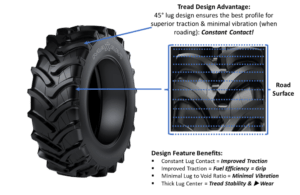
If you then compare tractor or harvester designed tires to sprayer tires, there are specific items to consider that are uniquely inherent to each farming application:
- Self-propelled sprayers will operate both at a slow 5 to 10 mph average in the field and at an average 40 mph when roading from field to field requiring a D rubber compounding.
- Due to heavy tank Loads in cyclic spraying operations, tires must be rated for heavy axle loads in terms of load index or load per tire.
- As sprayers operate when crops are in full bloom and therefore require high crop clearance, the resulting tire sidewall or tire air chamber is smaller which demands stronger structural casing materials and rubber compound designed for high air pressures equal to the load at hand.
- In addition, due to the constant roading of sprayer from field to field, tires designed for this application will have more lugs per tire to reduce the lug to void ratio increasing the amount of rubber contacting the surface ensuring improved stability under load and speed.
As a rule, when considering the above key product requirements that are very different for tractors, harvesters, and floaters vs sprayers, the below table captures the general comparative differences in tires by application:
![]()

As machines are getting larger especially with tractors and harvesters, we are seeing an evolution to “D” rated tires.
At 40 mph sustained road speeds, the shallower R1 tread depth ensures a more uniform distribution of load per lug and reduces irregular treadwear or cupping caused by tire slip when using deep treaded tires at high road torque or speed especially on high clearance self-propelled sprayers.
The advent of VF technology or tires that can carry 40% more load at standard air pressures has allowed high clearance self-propelled sprayer tires the ability to carry the load at reasonable air pressures that can deliver the performance required without compromising soil compaction. In the below example we demonstrate the load capacity of a standard 380/90R46 versus a VF380/90R46:
- Standard 380/90R46 AGRIXTRA N rated at 159A8/B can carry @25/30 mph with a maximum load of 9645 Lbs. at 58 PSI.
- VF380/90R46 AGRIXTRA N rated at 173D can carry @40 mph with a maximum load of 14330 Lbs. at 64 PSI.
- Therefore, at almost the same air pressure the VF tire carries +4600 Lbs. 10 mph faster than the standard tire.
- For a standard tire to carry the 14,000 lbs. you would need to increase the air pressure and slow down the equipment below 30 mph to meet the load.
- In a towed application any Sprayer tire must be inflated to the required axle load or tire load as speed is less of an issue.
- The better the air pressure management, the better the tire performance thus limiting compaction impact to the soil.
In sum, as a general rule the following sets a sprayer tire apart from a tractor tire: lower void ratio, higher weight carrying capacity, shallower tread, and higher speed rating.
Michelin Ag
David Graden: Operational Market Manager – Agriculture
When considering tires for a high clearance self-propelled sprayer, it is vitally important that you understand your needs and the limitations of the tires you choose. Your top two considerations should be safety and efficiency.
Compared to a tractor tire, the stability of a sprayer tire is of utmost importance. Sprayer tires are specifically designed to handle the constant pitch and sway of a machine loaded with liquid, in addition to the dynamic loads, with a very high center of gravity. As these machines continue to get larger and carry heavier loads, the tires also must meet or exceed these demands. Unfortunately, the width of these tires is not able to grow unless our row spacing widens. This, in turn, has forced the industry to move towards IF/VF tires. These tires can carry an additional 20% to 40% more load, while maintaining the necessary widths to fit down a row without damaging crops on either side.
Additionally, whereas tractors in North America are commonly B speed rated (30 mph), high clearance sprayers oftentimes travel 40 mph, requiring a D Speed Rating, with some sprayers traveling even faster- always check to make sure speed rating of tire matches top speed of equipment. Now, that being said, higher speeds will cause more movement in the lugs of a tire, or tread squirm. More movement creates friction and heat, which is bad for rubber, and increases rolling resistance. As a result, the lug design of a sprayer tire will look very different versus a tractor tire.
Typically, the lugs of a sprayer tire will be wider, shorter and with less void between the lugs. Wider and shorter lugs will offer more stability while less void between lugs (or more lugs per tire) and will give a smoother ride. Couple that with IF/VF technology, you will get more lugs on the ground for improved traction, in low torque applications, too. Remember, wider lugs designed for sprayer application work well both roading and in field, as this is a self-propelled machine.
In short, unless recommended by your tire dealer for very specific circumstances (i.e. reducing harmonic vibration by fitting sprayer tire with higher lug count to tractor), I highly recommend sticking with the manufacturer’s intent and using sprayer tires for sprayers and tractor tires for tractors, ensuring safe trouble free optimum performance.
Precision Inflation, LLC
Ken Brodbeck, VP of Technology
- Speed rating:
- Sprayers should be D speed rated since sprayers’ top speed is 30+ mph.
- Most tractors top speed is 30 mph or less, B rating covers to 30 mph.
- Tread pattern:
- Sprayers have heavier and more tread bars than tractors to handle high pressures during road transport.
- Tractors can have fewer, but deeper tread depth for better soil penetration.
- Load Rating:
- Sprayers have load ratings equal or greater than tractors but are usually narrow tires. This requires high pressures and a heavy tire body.
- Tractors use wider tires and run at lower pressures; this makes a more flexible tire body.
- Which is better, Standard, IF or VF?
- If soil compaction, flotation and soil health is important, then IF or VF are the best choice for sprayer and tractor high load requirements.
- With Central Tire Inflation System (CTIS), a Standard tire CAN beat VF!


*Standard Tire Inflation Pressure without CTIS = 26 PSI for both Field & Transport
Inflation system technology also improves the performance of IF and VF tires. In fact, every radial tire works better with inflation system technology to optimize the maximum performance of your farm. PrecisionInflation.com
All information is provided in this blog solely to provoke thought. All deductions made from information on this site must be confirmed by Certified Ag Tire Dealer and tire manufacturer where specified before use. Ag Tire Talk does not recommend anyone conduct tire service work with exception of Certified Ag Tire Dealer Professionals.

